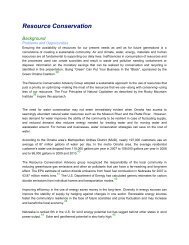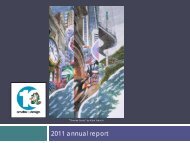Creating a new environmental vision for the city ... - Omaha By Design
Creating a new environmental vision for the city ... - Omaha By Design
Creating a new environmental vision for the city ... - Omaha By Design
You also want an ePaper? Increase the reach of your titles
YUMPU automatically turns print PDFs into web optimized ePapers that Google loves.
Page 4<br />
Section: Urban Form & Transportation<br />
ADVISORY<br />
COMMITTEE<br />
Marty Shukert, chair<br />
Linda Beacham and<br />
Theresa Baker,<br />
facilitators<br />
John Bartle<br />
Doug Bisson<br />
Christian Christensen<br />
Lynn Dittmer<br />
Herb Freeman<br />
Gary Gebhard<br />
Jim Grotrian<br />
Rick Jeffries<br />
Larry Jobeun<br />
Charlie Krajicek<br />
Derek Miller<br />
Bill Moore<br />
Jed Moulton<br />
Paul Mullen<br />
Norm Nelson<br />
Kerri Peterson<br />
Todd Pfitzer<br />
Curt Simon<br />
Tim Stuart<br />
Matt Tondl<br />
Jerry Torczon<br />
Katie Torpy<br />
Greg Youell<br />
Jenny Zimmer<br />
In 1950, <strong>Omaha</strong>'s population density (<strong>the</strong> number of people per unit of area) was about<br />
6,000 people per square mile. Today, it's substantially lower - about 3,490 people per<br />
square mile. What are we doing, or not doing, with all that space Are we hampering our<br />
ability to efficiently move around <strong>the</strong> <strong>city</strong> and provide <strong>the</strong> <strong>city</strong> services we all need and<br />
want The key elements in how our <strong>city</strong> is laid out - <strong>the</strong> type and location of housing, <strong>the</strong><br />
presence of sidewalks and trails, <strong>the</strong> type and location of employment centers, <strong>the</strong> physical<br />
design of our roads - all impact <strong>the</strong> way we navigate around <strong>Omaha</strong>. We know cars are<br />
important, but we also need to make room <strong>for</strong> walkers, bikers and those who would use<br />
mass transit if it was easy and got <strong>the</strong>m where <strong>the</strong>y needed to go. The six goals in this<br />
section of Environment <strong>Omaha</strong> seek to improve how <strong>Omaha</strong>ns move around <strong>the</strong> <strong>city</strong> and<br />
determine what shape its future growth should take.<br />
GOALS:<br />
Large-Scale City Form<br />
Develop a <strong>city</strong> <strong>for</strong>m that<br />
reduces <strong>the</strong> per capita cost<br />
of providing <strong>city</strong> services<br />
and establishes <strong>the</strong> density<br />
necessary to support more<br />
energy-efficient <strong>for</strong>ms of<br />
transportation.<br />
Land Use<br />
Development Policy<br />
Develop at high residential<br />
densities and with true mixed uses that produce more diverse environments and<br />
reduce <strong>the</strong> number of necessary automobile<br />
trips.




